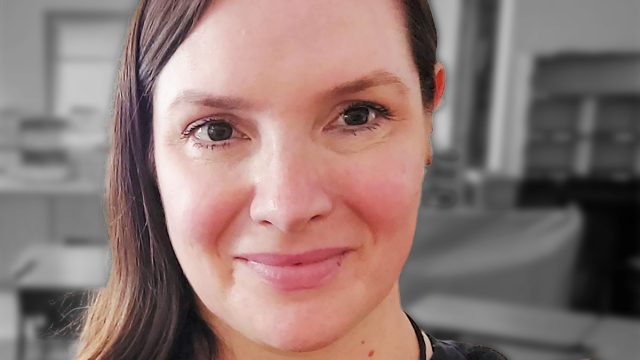Dance Trainer Reveals 6 Ballet Secrets for a Lean, Toned Body
A dancer's body exemplifies the perfect balance of strength and grace—the result of years of dedicated training. Through disciplined practice, dancers develop remarkable flexibility and muscle control that makes complex movements appear effortless. One of their key techniques is working in a turned-out position, rotating from the hips while maintaining precise alignment through the knees and toes. This specialized positioning engages muscles differently than traditional parallel-stance exercises.
The good news? You don't need years of dance experience to benefit from these techniques. I'm Annie Landry, and as a former dancer turned certified personal trainer and corrective exercise specialist, I've developed six gentle yet effective moves that can help anyone achieve a stronger, more graceful physique while protecting their joints.
My Journey from Dancer to Fitness Expert
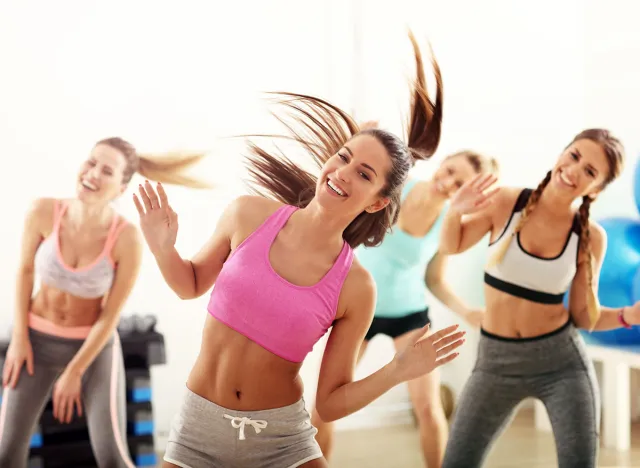
Dance has been a part of my life since I was three years old. A big part of my dance education focused on flexibility training and Pilates. I love to focus on complex movements that work multiple muscle groups and/or incorporate stretching with strengthening for maximum benefits.
Now, as a former dancer and trainer, I use dance-based fitness moves to help my clients develop long, lean muscles. I love incorporating dance-based moves into fitness routines because they have a minimal impact on the joints but yield great results for strength and muscle tone.
What Makes Dance-Based Training So Effective for Transforming Your Body?
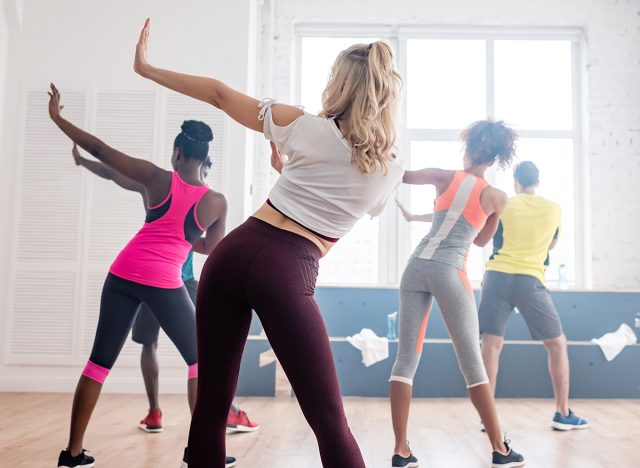
Dance, particularly ballet, lengthens the body while strengthening the muscles. Most people think they need heavy weights to see results, but dance training often requires use of body-weight which is very effective for toning. In technical dance training, we often move through the full range of motion. Simple modifications to exercises can improve results. When we actively engage the foot by pointing or flexing, we can better challenge the muscles that are activated in a leg lift, for example.
RELATED: Nutritionist Reveals 8 Simple Food Swaps That Actually Burn Fat
Before You Begin: Prepare Your Space
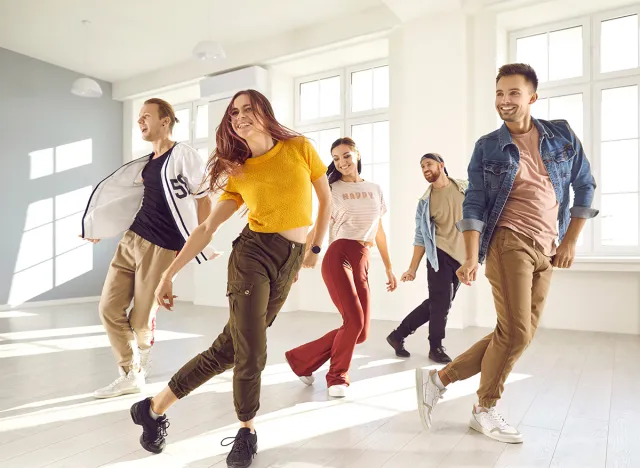
Before beginning any training program, you should receive clearance from a medical professional. If you are beginning a dance-based training program at home, you will also want to prepare your workout space by removing unnecessary obstacles.
I recommend completing exercises in front of a mirror. This will help you check your form to ensure that you are working safely and that you are engaging the proper muscles.
I also recommend using a base of support, such as a barre or the back of a chair, for the standing exercises. You can also use a kitchen counter or the back of the couch as a base of support, where you lightly rest your fingertips if the space is clear of other furniture, and you can move safely.
Sculpt Your Calves with Heel Lifts
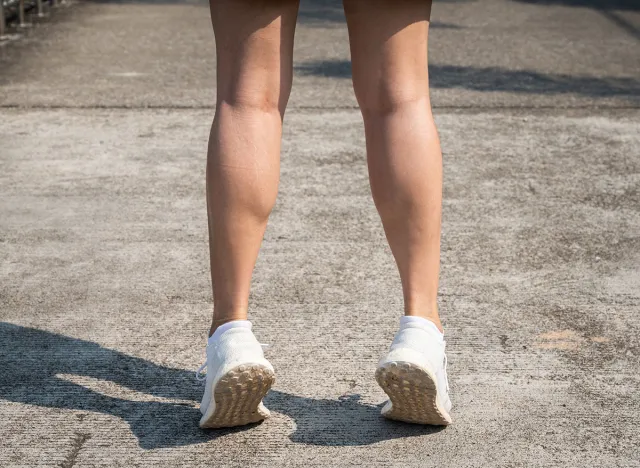
Engaging the core and placing the feet next to one another, gently lift the heels while keeping the legs straight. Try to rise as high up on the ball of the foot as you can, then gently lower down with straight legs. Aim for three sets of fifteen repetitions.
This exercise can be completed with or without a base of support. It is great for the calves and the core.
Target Your Lower Body with Second Position Pulses
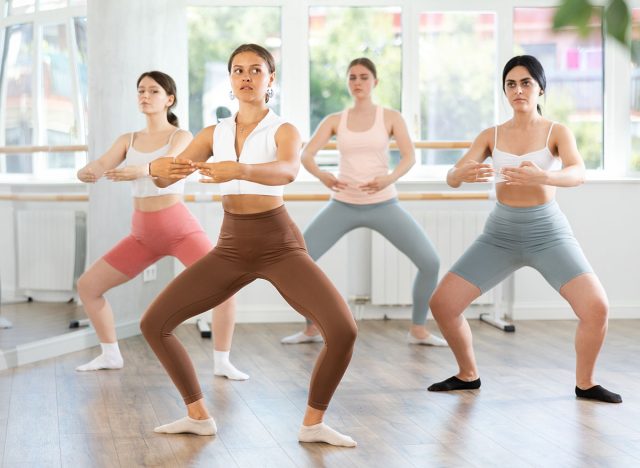
Step your feet slightly wider than shoulder-width apart. Rotating from the hip, turn the legs out to achieve 45 degrees of rotation in Second position. Lift the heels with straight legs so that you are balancing on the balls of the feet. Then, lower down into a plie position by bending the knees. Maintain your original turned-out position on the balls of the feet as you gently pulse up and down. Each pulse should only require you to lift and lower two to three inches. Try to pulse for one minute, then repeat two more times.
This exercise can be completed facing a barre or base of support and holding on with both hands. For more of a challenge, place one hand on the barre and the other on your hip or out to your side. For the biggest balance challenge, complete the exercise without a base of support, placing the hands on the hips or out to your sides.
This exercise is great for the entire lower body. You will feel your calves and quads fire up. You may also feel a stretch in your inner thighs and the engagement of the rotator muscles underneath your seat. Engaging the core throughout the exercise helps you maintain control and a safe posture, in addition to giving you a great abdominal and back workout.
RELATED: This Weight Loss Coach Reveals 5 Unexpected Tricks That Actually Work
Tone Your Core with Flat-back Arabesque Taps
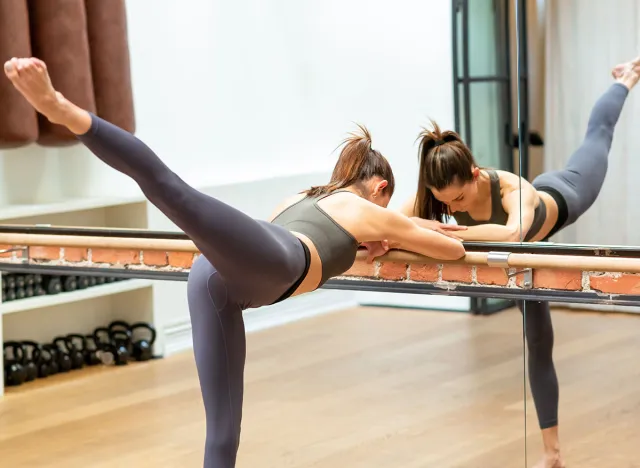
Place your hands on the base of the support and walk back a few steps until you reach a flat-back position with the torso parallel to the floor. Send one leg behind you, placing the inside of the big toe on the floor. Maintain a slight bend in the standing leg. Lift the leg with the foot pointed, maintaining the turned-out position of the leg. Aim for a 90-degree lift, then return the leg to the starting position. Try fifteen repetitions on each side, then repeat two times.
This exercise engages the core and tones the outside of the leg. Lengthen the working leg by maintaining a straight leg and sending energy out through a pointed working foot.
Build Balance with Down Dog Hand Taps
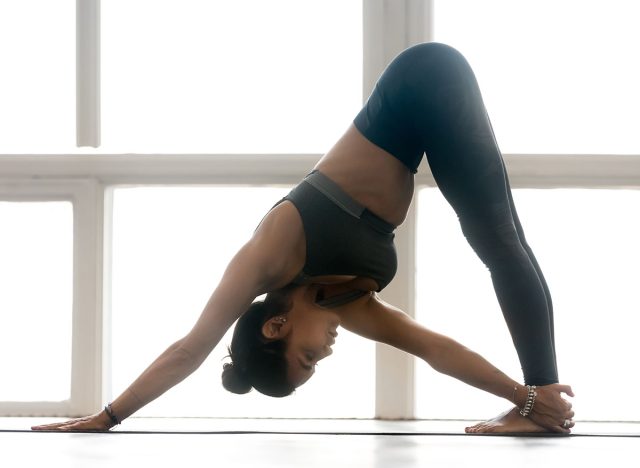
This exercise improves balance while stretching and lengthening through the spine and backs of the legs. Begin on the floor in a tabletop position, stacking your knees under the hips and hands under the shoulders. Then, send the hips high, straighten the legs, and shift the hips back into a downward-facing dog position. Maintaining your balance, lift one hand and tap it to the opposite shoulder. Return the hand to the starting position, then repeat on the other side. Do this for one minute, then repeat two more times.
Strengthen Your Hips with Side-lying Leg Circles
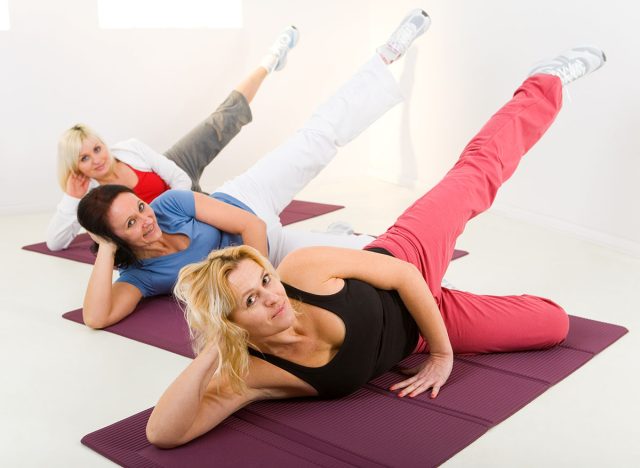
Gently lie on one side, engage the core, and stack the hips directly on top of one another. Bring the feet slightly in front of you, hollowing out the torso. Slowly and with control, swing the top leg forward 90 degrees, then up to 180 degrees, and down behind the torso 90 degrees, making a full circle. Repeat fifteen times on each side, then try two more sets.
This exercise is great because it stretches the front of the hip flexors and engages the core, quads, and rotator muscles.
RELATED: 10 Simple Stretches to Boost Flexibility and Relieve Tension Like a Dancer
Define Your Core with Supine Kicks
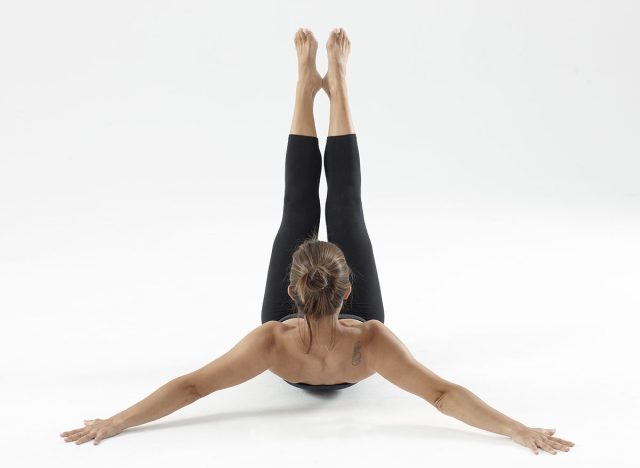
Lying on the floor with arms out to the side, lift the legs 90 degrees so that the feet are pointing towards the ceiling. Rotating from the hip, turn the toes out to 45 degrees into the first position. Pressing your spine into the floor and engaging your core, lower one leg to hover just above the floor. With control and maintaining a straight leg, return the leg to the starting position. Repeat on the other side. Do this for one minute, then repeat two more times.
This exercise is great for the abdominal muscles because you keep the core engaged for stability as you engage the quads and outer leg in a turned-out position. Pointed feet will also better engage your calf muscles.
Incorporating these exercises into your fitness routine will challenge and improve your strength and flexibility. As all these moves require core strength and stability, you can experience improved posture and balance with regular training, making the rest of your movements feel effortless. And if you enjoyed this article, don't miss 12-3-30 Walking Method: 20 Proven Tips to Lose Weight Faster.
